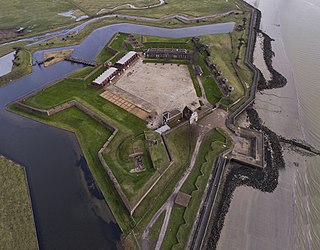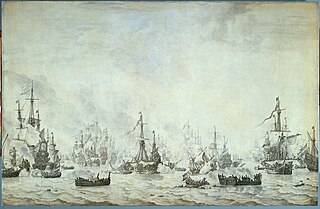
Carisbrooke Castle is a historic motte-and-bailey castle located in the village of Carisbrooke, Isle of Wight, England. Charles I was imprisoned at the castle in the months prior to his trial.

A fire ship or fireship is a large wooden vessel set on fire to be used against enemy ships during a ramming attack or similar maneuver. Fireships were used to great effect against wooden ships throughout naval military history up until the advent of metal-hulled ships; they could also serve a considerable function in shock and awe strategies to harm the morale of enemy crews. Ships used for fireship tactics were typically purpose-built or retrofitted from surplus or obsolete vessels, either of which could be filled with gunpowder or other combustibles before a battle, but could also be improvised from warships in active combat purposefully set on fire during engagements, such as if a vessel expended its munitions or had some other reason to be abandoned in battle.

Tilbury Fort, also known historically as the Thermitage Bulwark and the West Tilbury Blockhouse, is an artillery fort on the north bank of the River Thames in England. The earliest version of the fort, comprising a small blockhouse with artillery covering the river, was constructed by King Henry VIII to protect London against attack from France as part of his Device programme. It was reinforced during the 1588 Spanish Armada invasion scare, after which it was reinforced with earthwork bastion, and Parliamentary forces used it to help secure the capital during the English Civil War of the 1640s. Following naval raids during the Anglo-Dutch Wars, the fort was enlarged by Sir Bernard de Gomme from 1670 onwards to form a star-shaped defensive work, with angular bastions, water-filled moats and two lines of guns facing onto the river.

The Battle of the Downs took place on 21 October 1639, during the Eighty Years' War. A Spanish fleet, commanded by Admiral Antonio de Oquendo, was decisively defeated by a Dutch force under Lieutenant-Admiral Maarten Tromp. Victory ended Spanish efforts to re-assert naval control over the English Channel and confirmed Dutch dominance of the sea lanes, while it is also alleged to be the first major action to feature line of battle tactics.

The Anglo-Spanish War (1585–1604) was an intermittent conflict between the Habsburg Kingdom of Spain and the Kingdom of England that was never formally declared. It began with England's military expedition in 1585 to what was then the Spanish Netherlands under the command of Robert Dudley, Earl of Leicester, in support of the Dutch rebellion against Spanish Habsburg rule.

The fall of Antwerp on 17 August 1585 took place during the Eighty Years' War, after a siege lasting over a year from July 1584 until August 1585. The city of Antwerp was the focal point of the Protestant-dominated Dutch Revolt, but was forced to surrender to the Spanish forces under the command of Alessandro Farnese. Under the terms agreed, all the Protestants of Antwerp were given four years to settle their affairs and leave the city. Many migrated north, especially to Amsterdam. Apart from losing a high proportion of its middle class and mercantile population, Antwerp's trade suffered for two centuries afterwards as Dutch forts blockaded the River Scheldt until 1795.

The siege of Ostend was a three-year siege of the city of Ostend during the Eighty Years' War and the Anglo–Spanish War. A Spanish force under Archduke Albrecht besieged the fortress being held initially by a Dutch force which was reinforced by English troops under Francis Vere, who became the town's governor. It was said "the Spanish assailed the unassailable; the Dutch defended the indefensible." The commitment of both sides in the dispute over the only Dutch-ruled area in the province of Flanders made the campaign continue for longer than any other during the war. This resulted in one of the longest and bloodiest sieges in world history: more than 100,000 people were killed, wounded, or succumbed to disease during the siege.

Admiral Sir William Wynter held the office of Surveyor and Rigger of the Navy for 40 years, from 1549 until his death in 1589, and combined that with the office of Master of Navy Ordnance from 1557. He was an admiral and principal officer of the Council of the Marine under Queen Elizabeth I of England and served the crown during the Anglo-Spanish War (1585–1604). He was returned four times to parliament in Elizabeth's time.

The Spanish Armada was a Spanish fleet that sailed from Lisbon in late May 1588, commanded by Alonso de Guzmán, Duke of Medina Sidonia, an aristocrat without previous naval experience appointed by Philip II of Spain. His orders were to sail up the English Channel, join with the Duke of Parma in Flanders, and escort an invasion force that would land in England and overthrow Elizabeth I. Its purpose was to reinstate Catholicism in England, end support for the Dutch Republic, and prevent attacks by English and Dutch privateers against Spanish interests in the Americas.

The siege of Bergen op Zoom was a siege that took place between September 23 - November 13, 1588, during the Eighty Years' War and the Anglo–Spanish War. The siege took place in the aftermath of the Spanish Armada when famed commander Alexander Farnese, the Duke of Parma attempted to use his forces to besiege Bergen op Zoom, which was held by an Anglo-Dutch force under Thomas Morgan and Peregrine Bertie. An English officer named Grimstone, claiming to be a disaffected Catholic, had set up a trap during which a large Spanish assault was bloodily repulsed. An Anglo-Dutch relief column under the command Maurice of Orange arrived soon after and forced the Duke of Parma to retreat, thus ending the siege.

Hellburners, also known as explosion ships or Antwerp fire, were a pair of specialised explosive fireships built and fielded by the defending Dutch rebels in the Fall of Antwerp (1584–1585), part of the Eighty Years' War against the Habsburgs. The hellburners functioned as extremely powerful floating bombs and did immense damage to the Spanish besiegers, leaving a lasting impression on the Spanish sailors as to the fireship capabilities of their enemies. Hellburners have been described as an early form of weapons of mass destruction.

The Battle of the Narrow Seas, also known as the Battle of the Goodwin Sands or Battle of the Dover Straits was a naval engagement that took place on 3–4 October 1602 during the Anglo-Spanish War of 1585 and part of the Dutch Revolt. An English fleet under Sir Robert Mansell intercepted and attacked six Spanish galleys under the command of Federico Spinola in the Dover Straits. The battle was fought initially off the coast of England and finally off the Spanish Netherlands. The English were soon joined by a Dutch fleet under Jan Adriaanszoon Cant, and they completed the destruction.

The Battle of Sesimbra Bay was a naval engagement that took place on 3 June 1602, during the Anglo-Spanish War. It was fought off the coast of Portugal between an English naval expeditionary force sent out with orders by Queen Elizabeth I to prevent any further Spanish incursions against Ireland or England itself. The English force under Richard Leveson and William Monson met a fleet of Spanish galleys and a large carrack at Sesimbra Bay commanded by Álvaro de Bazán and Federico Spinola. The English were victorious in battle, sinking two galleys, forced the rest to retreat, neutralized the fort, and captured the carrack. It was the last expedition to be sent to Spain by orders of the Queen before her death the following year.
The Mutiny of Hoogstraten was the longest mutiny by soldiers of the Army of Flanders during the Eighty Years' War. Frederick Van den Berg's attempt to end the mutiny by force, with a siege to recapture the town, ended in defeat at the hands of an Anglo-Dutch army under of Maurice of Nassau. After a period of nearly three years the mutineers were able either to join Maurice's army or rejoin the Spanish army after a pardon had been ratified.

Gravesend Blockhouse was an artillery fortification constructed as part of Henry VIII's Device plan of 1539, in response to fears of an imminent invasion of England by European countries. It was built at Gravesend in Kent at a strategic point along the River Thames and was operational by 1540. A two-storey, D-shaped building built from brick and stone, it had a circular bastion overlooking the river and gun platforms extending out to the east and west. It functioned in conjunction with Tilbury Fort on the other side of the river, and was repaired in 1588 to deal with the threat of Spanish invasion, and again in 1667 when the Dutch navy raided the Thames. A 1778 report recommended alterations to the blockhouse and its defences, leading to the remodelling of the gun platforms and the construction of the new, larger New Tavern Fort alongside it. In the 1830s the government decided to rely entirely on the newer fort and the old blockhouse was demolished in 1844. Its remains were uncovered in archaeological excavations between 1975 and 1976.

The siege of Sluis (1604), also known as the Sluis campaign or the Battle of the Oostburg Line, was a series of military actions that took place during the Eighty Years' War and the Anglo–Spanish War from 19 May to 19 August 1604. A States and English army under Prince Maurice of Orange and Horace Vere respectively crossed the Scheldt estuary and advanced on land taking Cadzand, Aardenburg, and IJzendijke in the Spanish Netherlands. This soon led to the culmination of the siege of the Spanish-held inland port of Sluis.

The siege of Grave was a siege that took place between 18 July and 20 September 1602, as part of the Eighty Years' War and the Anglo–Spanish War. The Spanish-held city of Grave was besieged by a Dutch and English army led by Maurice of Orange and Francis Vere respectively. After a siege of nearly two months the city surrendered when a Spanish relief army under Francisco de Mendoza was defeated just outside the city by the besiegers. The defeat was severe enough to cause a major mutiny in the Spanish army.

The fortifications of Plymouth in Devon are extensive due to its natural harbour, its commanding position on the Western Approaches and its role as the United Kingdom's largest naval base. The first medieval defences were built to defend Sutton Harbour on the eastern side of Plymouth Sound at the mouth of the River Plym, but by the 18th century, naval activity had begun to shift westward to Devonport at the mouth of the River Tamar. During the Victorian era, advances in military technology led to a huge programme of fortification encompassing the whole of Plymouth Sound together with the overland approaches. Many of these works remained in military use well into the 20th century.

A Column of Fire is a 2017 novel by British author Ken Follett, first published on 12 September 2017. It is the third book in the Kingsbridge Series, and serves as a sequel to 1989's The Pillars of the Earth and 2007's World Without End.

The Battle of Cape St. Vincent was a naval engagement that took place on 16 June or 6 October 1606, during Eighty Years' War and Dutch–Portuguese War. A Spanish fleet under Admiral Luis Fajardo attacked the Dutch fleet led by Admiral Willem Haultain and Vice Admiral Regnier Klaazoon, which was blocking the Spanish-Portuguese coast to intercept the Spanish treasure fleet. The battle concluded in a Spanish victory; in which Klaazoon's flagship was destroyed, two ships were captured, and Haultain fled with the rest of the fleet to his country without having achieved his purpose.




















